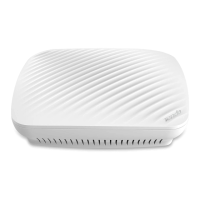22
This IP address also functions as the management IP address of the AP. You can
use this IP address to log in to the web UI of the AP to manage the AP.
It specifies the subnet mask of the IP address of the AP if IP Address Type is set to
Static. The default subnet mask is 255.255.255.0 and you can change it as required.
It specifies the gateway of the AP if IP Address Type is set to Static. The default
gateway IP address is 192.168.0.1 and you can change it as required.
It specifies the primary DNS server of the AP if IP Address Type is set to Static. The
default IP address of the primary DNS server is 8.8.8.8 and you can change it as
required.
It specifies the secondary DNS server of the AP if IP Address Type is set to Static. This
IP address is optional.
It specifies the device name of the AP. The default device name is in the format of
Model + Hardware version number.
You are recommended to change the device name so that you can quickly locate the
AP when managing the AP remotely.
Driving Capability of
Port
It specifies the Ethernet mode of LAN of this AP.
Standard: This mode features a high transmission rate but short transmission
distance. Generally, this mode is recommended.
Enhanced (lower port speed): This mode features a long transmission distance but
relatively low transmission rate (10 Mbps).
This mode is recommended only if the Ethernet cable that connects the LAN port of
the AP to a peer device exceeds 100 meters. In this case, the connected LAN port of
the peer device must work in auto-negotiation mode. Otherwise, the LAN port of the
AP may not be able to properly transmit or receive data.
If you change the IP address of the LAN port, change the IP address of your management computer as
well so that the two IP addresses belong to the same network segment. Then, use the new IP address
of the LAN port to log in to the web UI of the AP.
6.1.1 IP address obtaining mode – static IP address
This mode enables you to set the IP address, subnet mask, gateway IP address, primary DNS server,
and secondary DNS server of the AP. It is applicable to a scenario with only one or a few APs.

